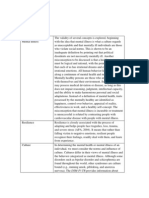Somatization Disorder
Somatization Disorder
Uploaded by
Mohd FahamyCopyright:
Available Formats
Somatization Disorder
Somatization Disorder
Uploaded by
Mohd FahamyOriginal Description:
Copyright
Available Formats
Share this document
Did you find this document useful?
Is this content inappropriate?
Copyright:
Available Formats
Somatization Disorder
Somatization Disorder
Uploaded by
Mohd FahamyCopyright:
Available Formats
Somatization Disorder
Somatization disorder is an illness of multiple somatic complaints in multiple organ systems that occurs over a period of several years and results in significant impairment or treatment seeking, or both. Somatization disorder is the prototypic somatoform disorder and has the best evidence of any of the somatoform disorders for being a stable and reliably measured entity over many years in individuals with the disorder. Somatization disorder differs from other somatoform disorders because of the multiplicity of the complaints and the multiple organ systems (e.g., gastrointestinal and neurological) that are affected. The disorder is chronic and is associated with significant psychological distress, impaired social and occupational functioning, and excessive medical -helpseeking behavior. Somatization disorder has been recognized since the time of ancient Egypt. An early name for somatization disorder was hysteria , a condition incorrectly thought to affect only women. (The word hysteria i s derived from the Greek word for uterus, hystera .) In the 17th century, Thomas Sydenham recognized that psychological factors, which he called antecedent sorrows, were involved in the pathogenesis of the symptoms. In 1859, Paul Briquet, a French phy sician, observed the multiplicity of symptoms and affected organ systems and commented on the usually chronic course of the disorder. Because of these clinical observations, the disorder was called Briquet's syndrome until the term somatization disor der became the standard in the United States.
Epidemiology
The lifetime prevalence of somatization disorder in the general population is estimated to be 0.2 percent to 2 percent in women and 0.2 percent in men. Women with somatization disorder outnumber me n 5 to 20 times, but the highest estimates may be because of the early tendency not to diagnose somatization disorder in male patients. Nevertheless, it is not an uncommon disorder. With a 5 -to-1 female-to-male ratio, the lifetime prevalence of somatizatio n disorder
among women in the general population may be 1 or 2 percent. Among patients in the offices of general practitioners and family practitioners, 5 to 10 percent may meet the diagnostic criteria for somatization disorder. The disorder is inversely r elated to social position and occurs most often among patients who have little education and low incomes. Somatization disorder is defined as beginning before age 30; it usually begins during a person's teenage years. Several studies have noted that somati zation disorder commonly coexists with other mental disorders. About two thirds of all patients with somatization disorder have identifiable psychiatric symptoms, and up to half have other mental disorders. Commonly associated personality traits or persona lity disorders are those characterized by avoidant, paranoid, self-defeating, and obsessive-compulsive features. Two disorders not seen more commonly in patients with somatization disorder than in the general population are bipolar I disorder and substance abuse.
Etiology
Psychosocial Factors
The cause of somatization disorder is unknown. Psychosocial formulations of the cause involve interpretations of the symptoms as social communication whose result is to avoid obligations (e.g., going to a job a person does not like), to express emotions (e.g., anger at a spouse), or to symbolize a feeling or a belief (e.g., a pain in the gut). Strict psychoanalytic interpretations of symptoms rest on the hypothesis that the symptoms substitute for repressed insti nctual impulses. A behavioral perspective on somatization disorder emphasizes that parental teaching, parental example, and ethnic mores may teach some children to somatize more than others. In addition, some patients with somatization disorder come from u nstable homes and have been physically abused. Social, cultural, and ethnic factors may also be involved in the development of symptoms.
Biological Factors
Some studies point to a neuropsychological basis for somatization disorder. These studies propose th at the patients have characteristic attention and cognitive impairments that result in the faulty perception and assessment of somatosensory inputs. The reported impairments include excessive distractibility, inability to habituate to repetitive stimuli, g rouping of cognitive constructs on an impressionistic basis, partial and circumstantial associations, and lack of selectivity, as indicated in some studies of evoked potentials. A limited number of brain -imaging studies have reported decreased metabolism i n the frontal lobes and the nondominant hemisphere.
Genetics
Genetic data indicate that, in at least some families, the transmission of somatization disorder has genetic components. Somatization disorder tends to run in families and occurs in 10 to 20 perc ent of the firstdegree female relatives of probands of patients with somatization disorder. Within these families, first degree male relatives are susceptible to substance abuse and antisocial personality disorder. One study also reported a concordance ra te of 29 percent in monozygotic twins and 10 percent in dizygotic twins, an indication of a genetic effect. The male relatives of women with somatization disorder show an increased risk of antisocial personality disorder and substance related disorders. Having a biological or adoptive parent with any of these three disorders increases the risk of developing antisocial personality disorder, a substance-related disorder, or somatization disorder.
Cytokines
Cytokines are messenger molecules that the immune system uses to communicate within itself and with the nervous system, including the brain. Examples of cytokines are interleukins, tumor necrosis factor, and interferons. Some preliminary experiments indicate that cytokines contribute to some of the nonspecif ic symptoms of disease, such as hypersomnia, anorexia, fatigue, and depression. The hypothesis that abnormal regulation of the cytokine system may result in some of the symptoms seen in somatoform disorders is
under investigation.
Diagnosis
For the diagnosis of somatization disorder, DSM -IV-TR requires onset of symptoms before age 30 (Table 17 2). During the course of the disorder, patients must have complained of at least four pain symptoms, two gastrointestinal symptoms, one sexual symptom, and one pseudoneurological symptom, none of which is completely explained by physical or laboratory examinations.
You might also like
- There Are Several Causes of DIDDocument6 pagesThere Are Several Causes of DIDZainab RashidNo ratings yet
- Gastroparesis Diet GuideDocument6 pagesGastroparesis Diet Guided1s7euu+rqc23kNo ratings yet
- Conceptual Frameworks and Theories in Psychiatric - Mental Health NursingDocument124 pagesConceptual Frameworks and Theories in Psychiatric - Mental Health NursingHui Chen100% (1)
- Case PresentationDocument6 pagesCase Presentationاكرم صالحين100% (1)
- 15.somatization DisorderDocument13 pages15.somatization DisorderGERSON RYANTONo ratings yet
- A Case Report of Obsessive-Compulsive DisorderDocument6 pagesA Case Report of Obsessive-Compulsive DisorderfonsoalNo ratings yet
- Most Question That The "Psychiatrist" Would Ask?Document1 pageMost Question That The "Psychiatrist" Would Ask?Chayantorn NimmanwathanaNo ratings yet
- Cluster C Personality DisordersDocument62 pagesCluster C Personality DisorderssarocamkentNo ratings yet
- Case StudyDocument7 pagesCase StudyAaron WallaceNo ratings yet
- Mh-Somatic Symptom Disorders - 2Document9 pagesMh-Somatic Symptom Disorders - 2martinNo ratings yet
- Depressive DisordersDocument9 pagesDepressive Disorderslengkong100% (1)
- Maladaptive Patterns of BehaviorDocument97 pagesMaladaptive Patterns of BehaviorKimTot OctavianoNo ratings yet
- Anxiety DisordersDocument39 pagesAnxiety DisordersAugene ToribioNo ratings yet
- Schizophrenia OverviewDocument8 pagesSchizophrenia OverviewRiscky LauwNo ratings yet
- Dissociative FugueDocument20 pagesDissociative FugueJayalakshmi KNo ratings yet
- EATING DISORDERS: Note Taking OutlineDocument6 pagesEATING DISORDERS: Note Taking OutlinePaula GarciaNo ratings yet
- Psychosis: Submitted By: 17-M-14 34-M-14 44-M-14 65-M-14 70-M-14Document71 pagesPsychosis: Submitted By: 17-M-14 34-M-14 44-M-14 65-M-14 70-M-14Sara MehboobNo ratings yet
- Overview of Mood DisordersDocument6 pagesOverview of Mood DisordersMaria Jezabel CaipangNo ratings yet
- Alcohol Dependence SyndromeDocument3 pagesAlcohol Dependence SyndromeMohd AminuddinNo ratings yet
- What Is Mental Health Illness ContinuumDocument2 pagesWhat Is Mental Health Illness ContinuumAileen A. MonaresNo ratings yet
- Schizophrenia Spectrum and Other Psychotic DisordersDocument54 pagesSchizophrenia Spectrum and Other Psychotic DisordersJR BetonioNo ratings yet
- Schizophrenia and Other Psychoses: Psychosis - Is A Disruptive Mental State inDocument7 pagesSchizophrenia and Other Psychoses: Psychosis - Is A Disruptive Mental State inDhen MarcNo ratings yet
- Case 2Document8 pagesCase 2Kreshnik IdrizajNo ratings yet
- Mental Status EvaluationDocument7 pagesMental Status Evaluationmunir houseNo ratings yet
- Elimination Disorder: Presented by Saba AhmedDocument49 pagesElimination Disorder: Presented by Saba AhmedRana Ahmad Gulraiz100% (1)
- NeurosisDocument11 pagesNeurosisSharika sasiNo ratings yet
- Rheumatoid Arthritis: Pathophysiology PathophysiologyDocument34 pagesRheumatoid Arthritis: Pathophysiology PathophysiologyOmair RiazNo ratings yet
- Nursing Precautions For Suicidal PatientDocument6 pagesNursing Precautions For Suicidal PatientSimran JosanNo ratings yet
- Hildegard Peplau Interpersonal RelationsDocument17 pagesHildegard Peplau Interpersonal RelationsRosechelle Baggao Siupan-ElarcoNo ratings yet
- Agoraphobia in Adults - Epidemiology, Pathogenesis, Clinical Manifestations, Course, and Diagnosis PDFDocument8 pagesAgoraphobia in Adults - Epidemiology, Pathogenesis, Clinical Manifestations, Course, and Diagnosis PDFdreamingNo ratings yet
- Paraphilic DisorderDocument15 pagesParaphilic DisorderMayan BonifacioNo ratings yet
- Anorexia Nervosa CalvinaDocument21 pagesAnorexia Nervosa CalvinaIndah Permata SariNo ratings yet
- Risk For ViolenceDocument5 pagesRisk For Violencemikaela_pascuaNo ratings yet
- 13.6factitious Disorder: Simulate, Induce, or Aggravate Illness To Receive Medical Attention, RegardlessDocument5 pages13.6factitious Disorder: Simulate, Induce, or Aggravate Illness To Receive Medical Attention, Regardlessleeperlhan2000No ratings yet
- Neurotic Disorders and SomatisationDocument26 pagesNeurotic Disorders and SomatisationNaveen Eldose100% (1)
- Classifying Mental Illness QuizDocument2 pagesClassifying Mental Illness Quizapi-269113291No ratings yet
- Treatment Modalities Applicable To The Psychiatric ClientDocument53 pagesTreatment Modalities Applicable To The Psychiatric Clientnickybore100% (1)
- Somatoform DisordersDocument40 pagesSomatoform DisordersDr-Mohamed EssawyNo ratings yet
- Alzheimeru2019s DiseaseDocument17 pagesAlzheimeru2019s Diseaseapi-262538456100% (1)
- Psychotic DisordersDocument52 pagesPsychotic DisordersYazan Mahafza100% (2)
- Somatoform DisordersDocument6 pagesSomatoform Disordersgeorgeloto12No ratings yet
- Disturbances in Thought KJW 161Document23 pagesDisturbances in Thought KJW 161zulfantri1983No ratings yet
- Vacarolis Chapter OutlinesDocument181 pagesVacarolis Chapter Outlinesamashriqi100% (1)
- Schizophrenia PDFDocument32 pagesSchizophrenia PDFJoyVee Pillagara-De LeonNo ratings yet
- Class II Neurotic DisordersDocument37 pagesClass II Neurotic DisordersNarayan K Ghorapde100% (1)
- Outline of A Mental Status AssessmentDocument7 pagesOutline of A Mental Status AssessmentAnnalisa TellesNo ratings yet
- Cccccy: My My My MyDocument11 pagesCccccy: My My My MyMichael Labial ApostolNo ratings yet
- Reflective Essay OutlineDocument2 pagesReflective Essay OutlineZandiNo ratings yet
- GRP 4 CLO 2 Concept Map PT 1 PDFDocument14 pagesGRP 4 CLO 2 Concept Map PT 1 PDFMaria Lyn Ocariza ArandiaNo ratings yet
- Psychiatric Assessment TechniquesDocument6 pagesPsychiatric Assessment Techniquesjme404No ratings yet
- Neurocognitive DisordersDocument26 pagesNeurocognitive DisordersGede GiriNo ratings yet
- Personality Disorders: Causes/syc-20354463Document5 pagesPersonality Disorders: Causes/syc-20354463Ctmanis Nyer100% (1)
- B - Mental Health and Substance AbuseDocument8 pagesB - Mental Health and Substance AbuseNeil Victor Ongco PajugotNo ratings yet
- TrichotillamaniaDocument10 pagesTrichotillamaniaTaraNo ratings yet
- Psychology Unit IV PDFDocument2 pagesPsychology Unit IV PDFOmprakash SwamiNo ratings yet
- Rights of Mental Patients and Types of AdmissionDocument31 pagesRights of Mental Patients and Types of Admissioncasandra moranteNo ratings yet
- Mood DisordersDocument78 pagesMood Disorderspawan_sharma_55No ratings yet
- PsychopharmacologyDocument14 pagesPsychopharmacologyMarielie OclimaNo ratings yet
- Alcohol Dependence, As Described in TheDocument4 pagesAlcohol Dependence, As Described in Thematthew.dyson2663No ratings yet
- CHAPTER 16 - Schizophrenia 2Document15 pagesCHAPTER 16 - Schizophrenia 2Rebecca100% (1)
- IL Take Care User GuideDocument27 pagesIL Take Care User GuidesusannNo ratings yet
- The Market Gap Report - 2009Document596 pagesThe Market Gap Report - 2009mactechNo ratings yet
- 2009 11 Oral GalvanismDocument2 pages2009 11 Oral GalvanismSppatilNo ratings yet
- Policy As A Tool For Research and Translation in Social EpidemiologyDocument22 pagesPolicy As A Tool For Research and Translation in Social EpidemiologyinetNo ratings yet
- The Psychological Effects of UnemploymentDocument4 pagesThe Psychological Effects of UnemploymentHayaton IRNo ratings yet
- Homans' Sign Vascular Disease: Prepared By: Rachelle Ann R. Recio II-Nur7, RLE 1Document28 pagesHomans' Sign Vascular Disease: Prepared By: Rachelle Ann R. Recio II-Nur7, RLE 1Karlo ReyesNo ratings yet
- Enclosures: YSQ-S and YPI YSQ - S2Document16 pagesEnclosures: YSQ-S and YPI YSQ - S2International Medical PublisherNo ratings yet
- Ophthalmia NodosaDocument15 pagesOphthalmia NodosaPrince AmissahNo ratings yet
- Impact of Corporate Social Responsibility On Profitability of Islamic and Conventional Financial InstitutionsDocument12 pagesImpact of Corporate Social Responsibility On Profitability of Islamic and Conventional Financial Institutionsnauman yunusNo ratings yet
- Assignment of AndiDocument9 pagesAssignment of Andisushila napit0% (1)
- Ayurvedic Science PDFDocument180 pagesAyurvedic Science PDFsharing the modest knowledge100% (5)
- Palliative Care Guiding Principles and ResourcesDocument1 pagePalliative Care Guiding Principles and ResourcesJully TNo ratings yet
- Brjindmed00212 0070Document2 pagesBrjindmed00212 0070Prakash PrabhakarNo ratings yet
- Virginia Henderson: Definition of NursingDocument37 pagesVirginia Henderson: Definition of NursingRotsen B. VelascoNo ratings yet
- Visa Letter TemplateDocument2 pagesVisa Letter TemplateGeetha Ganju100% (1)
- HINAI® 5.9.22 - SR01 LiveDocument1 pageHINAI® 5.9.22 - SR01 Livedara.kurniasariNo ratings yet
- Preliterate Times The Medieval Period: Era of Magico - Religious Explanation Era of AlienationDocument6 pagesPreliterate Times The Medieval Period: Era of Magico - Religious Explanation Era of AlienationJezreel Joyce RufiñoNo ratings yet
- LHB2017Document238 pagesLHB2017haslinda84100% (2)
- 02 HSQ Article Martin Et AlDocument28 pages02 HSQ Article Martin Et AlAndrea NegriNo ratings yet
- Evaluation of Anthelmintic Activity and Composition of Pumpkin (Cucurbita Pepo L.) Seed Extracts-In Vitro and in Vivo StudiesDocument21 pagesEvaluation of Anthelmintic Activity and Composition of Pumpkin (Cucurbita Pepo L.) Seed Extracts-In Vitro and in Vivo StudiesMaria Luiza CraciunNo ratings yet
- मलिन बस्ती की शैक्षिक समस्याओं का अध्ययनDocument6 pagesमलिन बस्ती की शैक्षिक समस्याओं का अध्ययनSumit KumarNo ratings yet
- Gestalt Therapy Approach To PsychopathologyDocument11 pagesGestalt Therapy Approach To PsychopathologyNina S MoraNo ratings yet
- Polarity - Stone's Polarity TherapyDocument4 pagesPolarity - Stone's Polarity Therapykabshiel75% (4)
- Personal Statement: Professional Experience SummaryDocument2 pagesPersonal Statement: Professional Experience SummaryODIBA MIRACLE IKOJONo ratings yet
- Diaphragm Lecture 1Document2 pagesDiaphragm Lecture 1Unspe XiNo ratings yet
- SC IAFN State StandardsDocument10 pagesSC IAFN State Standardspamelad02No ratings yet
- Jsa For Unloading - Shifting of Heavy Materials (Panels, Transformers, Cable Drums Etc.)Document1 pageJsa For Unloading - Shifting of Heavy Materials (Panels, Transformers, Cable Drums Etc.)noahlungu96No ratings yet
- Insha - Personal ValuesDocument2 pagesInsha - Personal ValuesAli Aman QaisarNo ratings yet
- Applicationform Draft Print For AllDocument2 pagesApplicationform Draft Print For AllAkash MponlineNo ratings yet

























































































